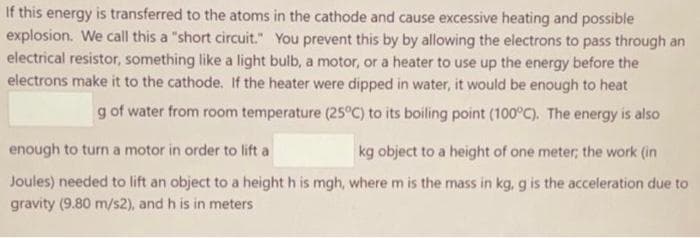KE gained by one electron (e) (Ecot) = (1.602x10 C) (9.37 V) CV (three significant digits). Note: one coulomb volt is equivalent to one joule; 1 CV = 1J.
KE gained by one electron (e) (Ecot) = (1.602x10 C) (9.37 V) CV (three significant digits). Note: one coulomb volt is equivalent to one joule; 1 CV = 1J.
Chemistry & Chemical Reactivity
9th Edition
ISBN:9781133949640
Author:John C. Kotz, Paul M. Treichel, John Townsend, David Treichel
Publisher:John C. Kotz, Paul M. Treichel, John Townsend, David Treichel
Chapter20: Environmental Chemistry-earth's Environment, Energy, And Sustainability
Section: Chapter Questions
Problem 31PS
Related questions
Question
These two pictures go together with the same information and really need the answers as soon as possible!

Transcribed Image Text:If this energy is transferred to the atoms in the cathode and cause excessive heating and possible
explosion. We call this a "short circuit." You prevent this by by allowing the electrons to pass through an
electrical resistor, something like a light bulb, a motor, or a heater to use up the energy before the
electrons make it to the cathode. If the heater were dipped in water, it would be enough to heat
g of water from room temperature (25°C) to its boiling point (100°C). The energy is also
enough to turn a motor in order to lift a
kg object to a height of one meter; the work (in
Joules) needed to lift an object to a height h is mgh, where m is the mass in kg, g is the acceleration due to
gravity (9.80 m/s2), and h is in meters
![KE gained by one electron (e) (E)= (1.602x10 C) (9.37 V)
CV (three significant digits). Note: one coulomb volt is equivalent to
one joule; 1 CV = 1J.
What would be the total kinetic energy gained by a mole of electrons? First, let us calculate the charge of
one mole of electrons; this is called Faraday's constant. We just multiply the charge one electron by
Avogadro's number (NA = 6.022x103 mol ').
F= (N (e) =
C mol (three significant digits)
KE gained by of one mole of electrons = NA (e) (Ece) Or (F)(Ec)
J/mol (three significant digits)
The kinetic energy that would be gained by n moles of electrons is (n)(FXEc«t}. A typical 9-V battery can
put out a current of 0.58 A. One ampere (A) is equivalent a Coulomb per second. How much KE will be
gained by electrons in one minute? First we calculate n, the moles of electrons in one minute.
n= [(0.58 C/s) divided by (96500 C/mol) | times (60 seconds] =
mol
KE (n)(F)(E)
J(three significant digits)](/v2/_next/image?url=https%3A%2F%2Fcontent.bartleby.com%2Fqna-images%2Fquestion%2F48e43d24-e797-4c18-89f0-87785ffa58f5%2F2dab8ebb-ecd5-4729-b3f7-6139e0170166%2Fss0fyt_processed.jpeg&w=3840&q=75)
Transcribed Image Text:KE gained by one electron (e) (E)= (1.602x10 C) (9.37 V)
CV (three significant digits). Note: one coulomb volt is equivalent to
one joule; 1 CV = 1J.
What would be the total kinetic energy gained by a mole of electrons? First, let us calculate the charge of
one mole of electrons; this is called Faraday's constant. We just multiply the charge one electron by
Avogadro's number (NA = 6.022x103 mol ').
F= (N (e) =
C mol (three significant digits)
KE gained by of one mole of electrons = NA (e) (Ece) Or (F)(Ec)
J/mol (three significant digits)
The kinetic energy that would be gained by n moles of electrons is (n)(FXEc«t}. A typical 9-V battery can
put out a current of 0.58 A. One ampere (A) is equivalent a Coulomb per second. How much KE will be
gained by electrons in one minute? First we calculate n, the moles of electrons in one minute.
n= [(0.58 C/s) divided by (96500 C/mol) | times (60 seconds] =
mol
KE (n)(F)(E)
J(three significant digits)
Expert Solution
This question has been solved!
Explore an expertly crafted, step-by-step solution for a thorough understanding of key concepts.
This is a popular solution!
Trending now
This is a popular solution!
Step by step
Solved in 4 steps with 1 images

Knowledge Booster
Learn more about
Need a deep-dive on the concept behind this application? Look no further. Learn more about this topic, chemistry and related others by exploring similar questions and additional content below.Recommended textbooks for you

Chemistry & Chemical Reactivity
Chemistry
ISBN:
9781133949640
Author:
John C. Kotz, Paul M. Treichel, John Townsend, David Treichel
Publisher:
Cengage Learning

Chemistry & Chemical Reactivity
Chemistry
ISBN:
9781337399074
Author:
John C. Kotz, Paul M. Treichel, John Townsend, David Treichel
Publisher:
Cengage Learning

General Chemistry - Standalone book (MindTap Cour…
Chemistry
ISBN:
9781305580343
Author:
Steven D. Gammon, Ebbing, Darrell Ebbing, Steven D., Darrell; Gammon, Darrell Ebbing; Steven D. Gammon, Darrell D.; Gammon, Ebbing; Steven D. Gammon; Darrell
Publisher:
Cengage Learning

Chemistry & Chemical Reactivity
Chemistry
ISBN:
9781133949640
Author:
John C. Kotz, Paul M. Treichel, John Townsend, David Treichel
Publisher:
Cengage Learning

Chemistry & Chemical Reactivity
Chemistry
ISBN:
9781337399074
Author:
John C. Kotz, Paul M. Treichel, John Townsend, David Treichel
Publisher:
Cengage Learning

General Chemistry - Standalone book (MindTap Cour…
Chemistry
ISBN:
9781305580343
Author:
Steven D. Gammon, Ebbing, Darrell Ebbing, Steven D., Darrell; Gammon, Darrell Ebbing; Steven D. Gammon, Darrell D.; Gammon, Ebbing; Steven D. Gammon; Darrell
Publisher:
Cengage Learning

Chemistry: Principles and Reactions
Chemistry
ISBN:
9781305079373
Author:
William L. Masterton, Cecile N. Hurley
Publisher:
Cengage Learning

Chemistry: An Atoms First Approach
Chemistry
ISBN:
9781305079243
Author:
Steven S. Zumdahl, Susan A. Zumdahl
Publisher:
Cengage Learning
